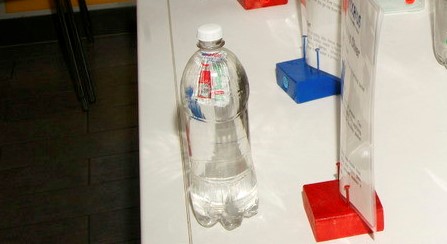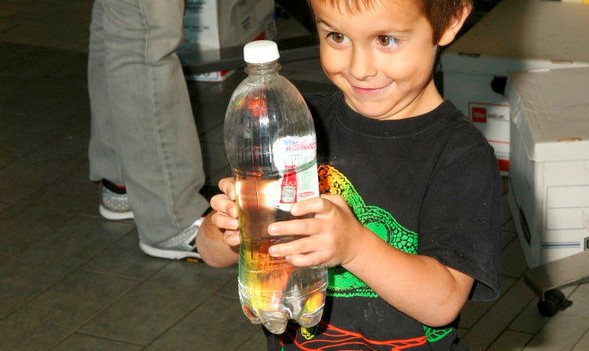Ketchup Diver
A bottle of water has a sauce packet floating at the top. When you squeeze the bottle, the packet sinks to the bottom! When you stop squeezing, the packet floats to the top again.
(This is a simpler variation of a Cartesian Diver.)
Materials
- A small clear plastic soda bottle or water bottle, 12 to 20 oz size
- About 30 sauce packets
- A larger clear plastic bottle with a wide opening at the top
Construction Instructions
The key to this creation is choosing the right sauce packet. The sauce by itself would sink, because it is more dense than water; in the same amount of space, it has more weight than water does. The packet floats because there's a little air bubble inside the packet. If you find a sauce packet that is transparent, you can see the air bubble. The air bubble takes up space without adding much weight, lowering the density of the packet, so it floats. When you squeeze the bottle, the water sqeezes the packet, the air bubble shrinks, and the packet becomes denser, so it falls.
With some sauce packets, squeezing the packet doesn't increase the density of the packet enough to make it sink, so you need to find a packet that is just barely floating. This means testing a lot of packets before you find just the right one.
You'll want to test a lot of different sauce packets. I tried 30 packets, of 10 different brands and sauce types, before I found one that worked. (It was duck sauce.) I'm told P. Terry's ketchup is a good one to try, as there is a lot of variation from packet to packet. McDonald's ketchup, on the other hand, is bad because all the packets tend to be the same so you don't gain anything by testing more of them. If you're like me, and you have lots of sauce packets in a drawer or the fridge left over from takeaway food, this is a great opportunity to use them for something.
Rinse the bottles well, and work over a sink or tub, or outdoors, in case the water spills.
Fill your large bottle with water. You need a bottle with a large opening so that it's easy to take the packets out later. A 52 oz iced tea bottle works well.
Put about 5 of the packets in the bottle. Fill the bottle all the way to the brim with water, and cap it without spilling any. You don't want a big air bubble in the bottle (but a small one is ok).
Most likely, none of the packets will sink, but if they do, put them in the reject pile.
Squeeze the bottle and see if any of the packets move. Turn the bottle upside-down and see which ones rise the slowest, that's good. Reject any that rise fast. You can also open the bottle to push the packets underwater with your finger and see which ones rise again the slowest, that's good.
Open the bottle, remove the packets, and repeat with a few more packets. Keep testing until you find one that just barely floats, and sinks when you squeeze the bottle.
When you find the perfect sauce packet, rejoice! Put it in the smaller display bottle, fill the bottle all the way up with water (no air bubble), cap it, and you're done!
Variations
If you want to make your ketchup diver a little more permament, you can put some duct tape around the cap. Some plastic bottles are porous, though, so over time they may lose water and shrink, and you might want to be able to open the bottle to refill it. For that reason, permanently gluing the cap on may not be advisable. You might also find that over time the sauce packet will lose some of its air pocket and it won't float any more, but that takes a year or more.


